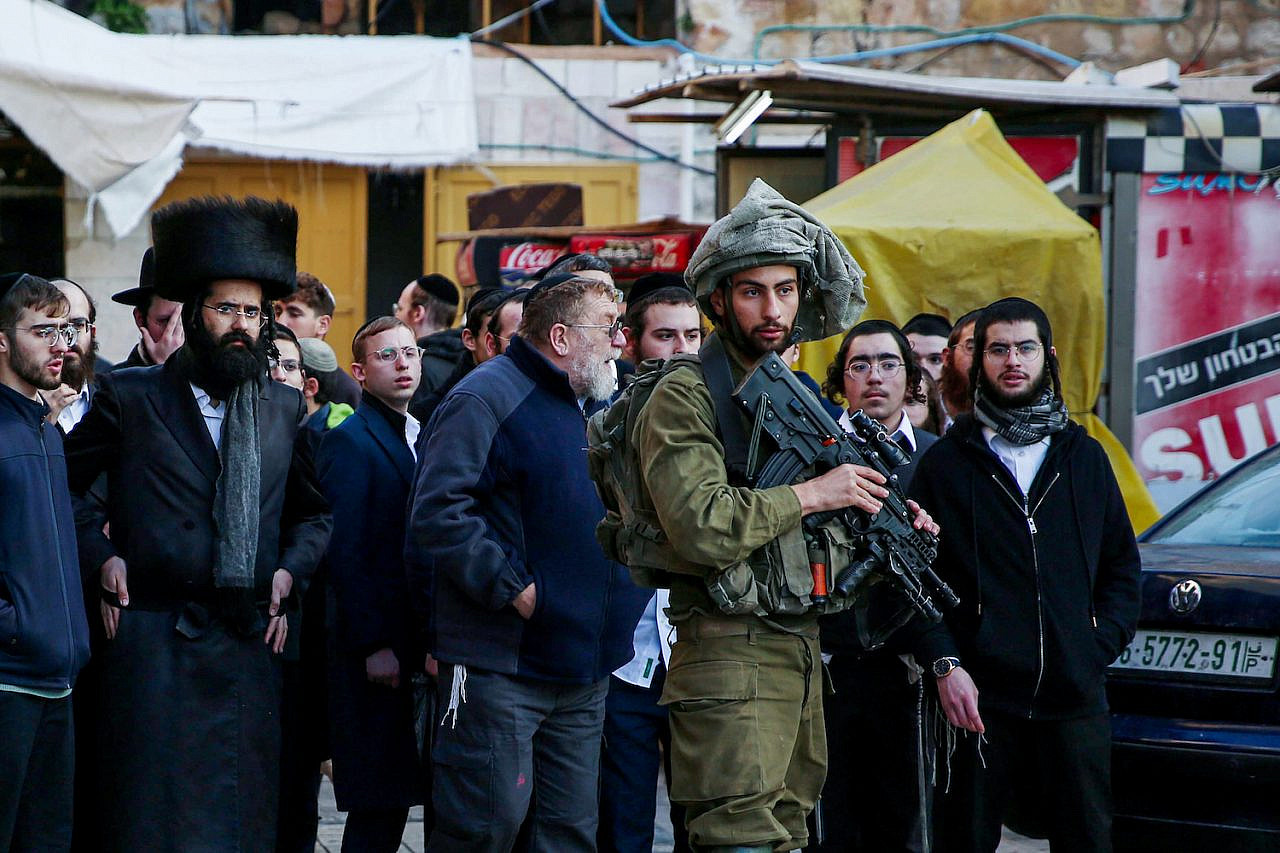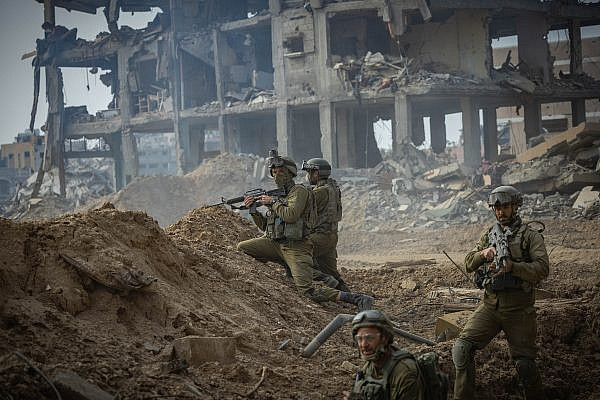Ever since the horrifying pogrom on Huwara on February 26, as revenge for the killing of two settlers, the Palestinian town has become one of the rallying cries in the protests against the new government and its proposed judicial overhaul. During the weekly protest in Tel Aviv on March 5, Israelis held a large banner depicting the portraits of Finance Minister Bezalel Smotrich and National Security Minister Itamar Ben Gvir that read “Yesterday Huwara — Tomorrow Israel.”
The banner reflects the concern of many of the protesters: that Israel’s antidemocratic policies in the West Bank will now be extended into all of Israel by Smotrich and Ben Gvir.
A man with a military emblem on his shirt marched next to the banner, chanting alongside many others: “Where were you in Huwara?” — a chant that has become prevalent at the demonstrations — aimed at the police’s failure to stop the pogrom, which contrasted with their violent crackdown on protesters in Tel Aviv. The man was surrounded by dozens of protesters waving Israeli flags.
At first glance, this appears to be a positive development in the protest movement: previously only the Israeli radical left, a small but consistent bloc in the massive weekly protests, was connecting the judicial overhaul to the fundamental lack of democratic rights for Palestinians living between the river and the sea. But does the incorporation of chants and signs about Huwara signal a wave of radicalization among the more mainstream protesters?

The answer, unfortunately, seems to be no. The protest movement is highly selective in choosing which violent incidents it denounces and which it overlooks, painting a discouraging portrait of the Israeli protest movement as ignorant of the structurally antidemocratic features of the Israeli regime. By failing to critique state-inflicted violence as well, the protest movement’s exclusive condemnation of settler violence not only rings hollow — it ultimately becomes illogical.
Just four days before the pogrom in Huwara, Israeli security forces invaded Nablus. Unsurprisingly, the invasion of an occupying force in the heart of a crowded city — in broad daylight, no less — sparked intense confrontations and armed resistance from the local population. During the raid, Israeli police and military units put down the resistance throughout the city while shooting at innocent bystanders who did not pose a direct threat to the soldiers.
After a few hours, the military and police forces withdrew from Nablus, leaving eleven Palestinians dead (most of whom were unarmed), more than a hundred wounded (over half with gunshot wounds), and severe damage across the city. The deadly outcome of the Nablus raid drew criticism from outside Israel, including from the United States. Investigations conducted by the New York Times and the Washington Post described what seems to be violations of international humanitarian law; in other words, it is possible Israeli security forces committed war crimes during the raid.
In stark contrast with the violent pogrom in Huwara, however, the Nablus raid (which some described as a massacre) drew hardly any criticism from the Israeli protesters fighting for “democracy.” With the sole exception of a few voices in the anti-occupation bloc, it appears that the vast majority of the protesters view the violent and potentially criminal invasion of Nablus as routine, even justified. This disparity in attention and condemnation could be seen in the Israeli media as well, even in liberal outlets, which devoted significant coverage to the pogrom in Huwara, while giving merely a passing mention to the military’s raid in Nablus.

Notwithstanding the gravity of the violence committed by Israeli citizens in Huwara and the racist ideology behind it, it is worth considering why Israeli liberals prioritize one horrifying incident of violence over another. Nablus and Huwara are located only a dozen or so miles apart; so why did the Israeli public treat the back-to-back incidents so differently?
Which Palestinians are worthy of being victims
Israeli domination over Palestinians is inherently violent. The more colonial control Israel imposes, the more it depends on and normalizes the regular use of lethal force. Every once in a while, an incident of Israeli colonial aggression manages to breach the usual indifference of Israeli society. This was the case in 2020, when Iyad al-Hallaq, a Jerusalem Palestinian with autism, was murdered by a Border Police officer; signs with Al-Hallaq’s portrait and the demand “Justice for Iyad” became commonplace within the Balfour protests against the previous Netanyahu administration.
The selective attention and outrage directed toward certain violent incidents but not others is revealing. These critiques emerge within the liberal-left in Israel only when the victim of occupation violence is “easier to bear,” and only when the victim manages to sufficiently prove their humanity to Israelis. Al-Hallaq, for example, was widely seen as harmless, clearing him of any suspected violence against the policemen who killed him. This framing made it easier for the pro-democracy faction in Israel to recognize him as a human being, and likely contributed to the prosecution of the policeman who killed him.
A similar result was achieved in Huwara, albeit via a different path. In this case, the residents of the town succeeded in proving their humanity, not only because they were clear victims of racist violence, but because of the identity of their attackers: Israeli civilians. In the eyes of most Israelis, the military has a monopoly on legitimate violence, so much so that supporting the violence of the military is usually not considered an ideological stance. So-called settler violence, in contrast, is perceived as vigilante violence, which many Israelis think can and should be denounced. The tendency of most Israelis to distinguish between settler and military violence rendered the Palestinian residents of Huwara more worthy of the status of victimhood than their neighbors in Nablus.
Most read on +972
A consequence of upholding Israeli state violence as the only legitimate force between the river and the sea is that all forms of Palestinian violence, even an act as small as throwing a rock, are viewed by Israeli society — even the left — as categorically illegitimate. This, despite the fact that the United Nations recognizes the right of nations to resist colonial rule and apartheid, and that the Ukrainian popular resistance to Russian occupation is applauded around the globe. And yet, Palestinians are seen as insufficiently worthy victims for the pro-democracy protest movement or the Israeli media.
A struggle for no democracy at all
The pogrom in Huwara is a singular and significant event in its scope and intensity. But violent acts committed by settlers are nothing fundamentally new. Civilian violence is a key component of the extreme right’s ideology in Israel and has been for decades: the Jewish underground carried out terror attacks against Palestinians in the 1980s; the right carried out revenge attacks in the early 2000s following the killing of Israelis during the Second Intifada; and there was a series of so-called price tag attacks that led to the murder of the Dawabsheh family.
Just as importantly, the collaboration between security forces and the Israeli far right is also not new. In fact, it is so deeply rooted in the history of the state that so-called “settler violence” and state violence cannot truly be separated. The artificiality of this distinction is particularly clear in the case of Huwara: though the incident was framed as settler violence, the military and police were present and even helped facilitate the attack on the village. “Settler violence” is state violence not merely because the military and settlers openly collaborate in violent acts against Palestinians, or because the police and military routinely fail to protect Palestinians from this violence, but because the State of Israel ultimately benefits from the far right’s violence. The state and the settlers share the same goals.

The pro-democracy protests consider the pogrom in Huwara to be beyond the scope of legitimate state violence. But the pogrom, like many other acts of settler violence before and since, is not distinct from the nature of Israeli domination over Palestinians for the last 75 years. From reprisal attacks (including the Qibya massacre) by Unit 101 commanded by Ariel Sharon and directed by David Ben-Gurion, through Yitzhak Rabin’s order to “break the arms and legs” of Palestinians who resist the occupation, to punitive home demolitions, revenge and collective punishment are an inseparable part of the Israeli means of domination. Vigilante acts of revenge are also an integral part of Israeli military history. Israel honors Meir Har Zion who murdered five Arab men in revenge for the murder of his sister.
The current fixation on the Huwara pogrom by the pro-democracy movement, and its incorporation into the protest’s slogans, seeks to distance this type of violence, which it deems illegitimate, from the reigning ideology in Israel. This attempt to distance settler from state violence even serves to further sanitize state violence as always legitimate: by condemning and denouncing only “settler violence,” the protest movement and the media deflect criticism away from and allow Israeli society to overlook the inherent violence of the state’s domination over Palestinians.
Counterintuitively, the way Huwara has been incorporated into the protest for Israeli democracy only serves violent Israeli rule. The condemnation of settler violence alone, the insistence on separating settler violence from military violence, and the preference for one victim of Israeli domination over another all serve to legitimize the institutionalized violence of the State of Israel, violence that is more frequent and far deadlier than that carried out directly by the settlers.
The refusal of the protest movement to critique state violence reveals its innate limitations. Chanting “Where were you in Huwara?” while carrying Israeli flags and donning military symbols suggests that criticism of the occupation is utilized solely as a tool for the current Israeli protest, rather than as a critique that would point toward a vision of genuine democracy for everyone living between the river and the sea. Resistance to Israeli domination and its brutality is a prerequisite for solidarity with the Huwara residents; otherwise, the struggle is for an exclusively Jewish democracy, which is no democracy at all.
This article was first published in Hebrew on Local Call. Read it here.





